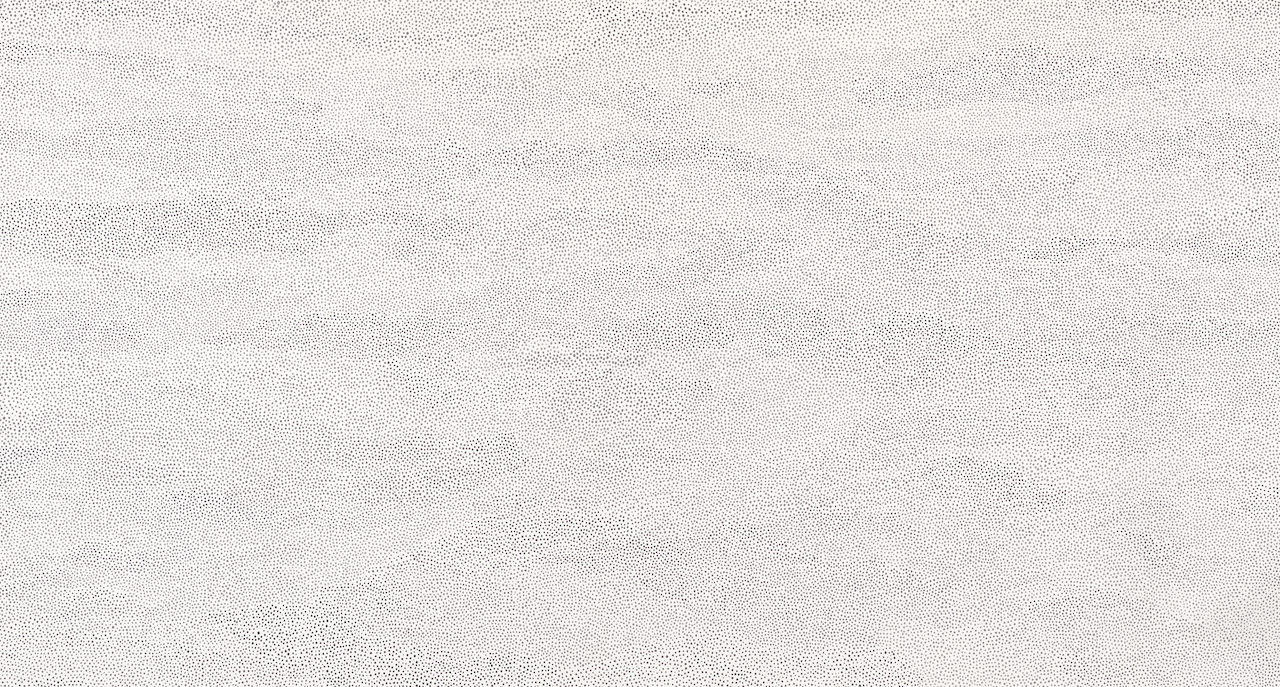Ink dot painting by Bei Dao, from the series “The Moment.” Photograph courtesy of Bei Dao.
Our new Fall issue includes an excerpt from Bei Dao’s book-length poem Sidetracks, translated from the Chinese by Jeffrey Yang. In Sidetracks, Bei Dao reflects on his turn to making ink-dot paintings like the one here.
In April 2012, while with his family on a beach in Hong Kong, Bei Dao suffered a stroke that severely affected his language abilities. After a month of trying to learn how to read all over again, he was assessed by a speech-language pathologist to be at only 30 percent equivalency. Daily conversation was difficult; the words he depended on for his life and art would possibly never return. It was an unprecedented crisis that he later compared in an essay to being “like an animal trapped in a cage.” (I’m reminded of these lines Bei Dao’s friend Tomas Tranströmer wrote after a paralyzing stroke, translated from the Swedish by Robin Fulton: “I am carried in my shadow / like a violin / in its black case.”) While recovering in the hospital, Bei Dao started to doodle and brush calligraphy, and when he returned home, he started to paint, channeling the lyric impulse from the void of words into physical images. Thirty years had passed since he’d last painted a picture.
Bei Dao’s first paintings in this period were composed of repeating lines that formed an abstract landscape resembling surging hills or waves. Feeling he lacked the necessary skill and technique to manipulate the plastic line, he abandoned it and turned to one of the most fundamental elements of Chinese painting: the ink dot. A longtime photographer, he compares the ink dot to the pixel of a photograph. In his book-length poem Sidetracks, which will be published in English by New Directions in 2024, he describes the creative process of ink-dot painting like this:
nebular ink dots on rice paper—in accord with the cosmos painting pictures makes me euphoric ink dots cluster disperse depending on the flow of random scattering forest beyond the borders of language good fortune depends on disaster / disaster conceals good fortune I am aimless freedom listening closely to the whispers of snowflakes guarding the vortex of day and night at the center of the mysterious river
Four years after his stroke, Bei Dao’s Chinese language abilities had improved dramatically, and a new medical assessment showed a recovery of over 80 percent. He continued his painting practice, though, and started to write poetry again. In 2018, a year before he turned seventy, Bei Dao had his first-ever painting exhibition at the Galerie Paris Horizon, located just north of the Centre Pompidou. In the essay he wrote for the exhibition, he contrasts the oil-based pointillism of an artist like Seurat with the watery ink dots of the East, where the tones and textures of the so-called five shades of ink in traditional Chinese painting must be naturally integrated with the brush and the rice paper to form a single whole. And as the water evaporates, the ink colors change, creating unexpected effects. He has experimented with using the cold colors of Japanese green ink alongside the warm colors of brown ink, while using sumi ink to deepen the tones and textures through a rhythmic layering. Around the time he began his new painting practice, he made a pilgrimage from Hong Kong to many cities across the mainland to learn about traditional Chinese medicine. He has received treatment from eight different traditional Chinese medical doctors who are well trained in the dialectical principles of yin and yang and the five elements as originally presented in the Yellow Emperor’s Inner Canon, which was compiled over two thousand years ago.
The artist Xu Bing—he and his wife, the poet Zhai Yongming, were the first collectors of Bei Dao’s paintings—wrote an essay for Bei Dao’s Paris exhibition in which he links his work with that of the Chinese maximalist artists: a loose grouping used in the early aughts to classify work that resonates with Western minimalism but that is also, as the art historian Gao Minglu has described it, closely tied to “the spiritual experience of the artist in the process of creation as a self-contemplation outside and beyond the artwork itself.” Xu Bing suggests that a maximalist style of compressed intensity and repetition are generally found in three kinds of artists: the formally untrained, such as the Aboriginal artists of Papunya in Australia; the physically or mentally ill, such as Yayoi Kusama; and contemporary artists who “dress up like a god and play a ghost.” The painting by Bei Dao shown here is from an ongoing series titled Cǐkè (The moment), which Xu Bing writes is a reflection of “a mixture of these three categories.”
Jeffrey Yang is the author of the poetry collections Line and Light; Hey, Marfa; Vanishing-Line; and An Aquarium.
